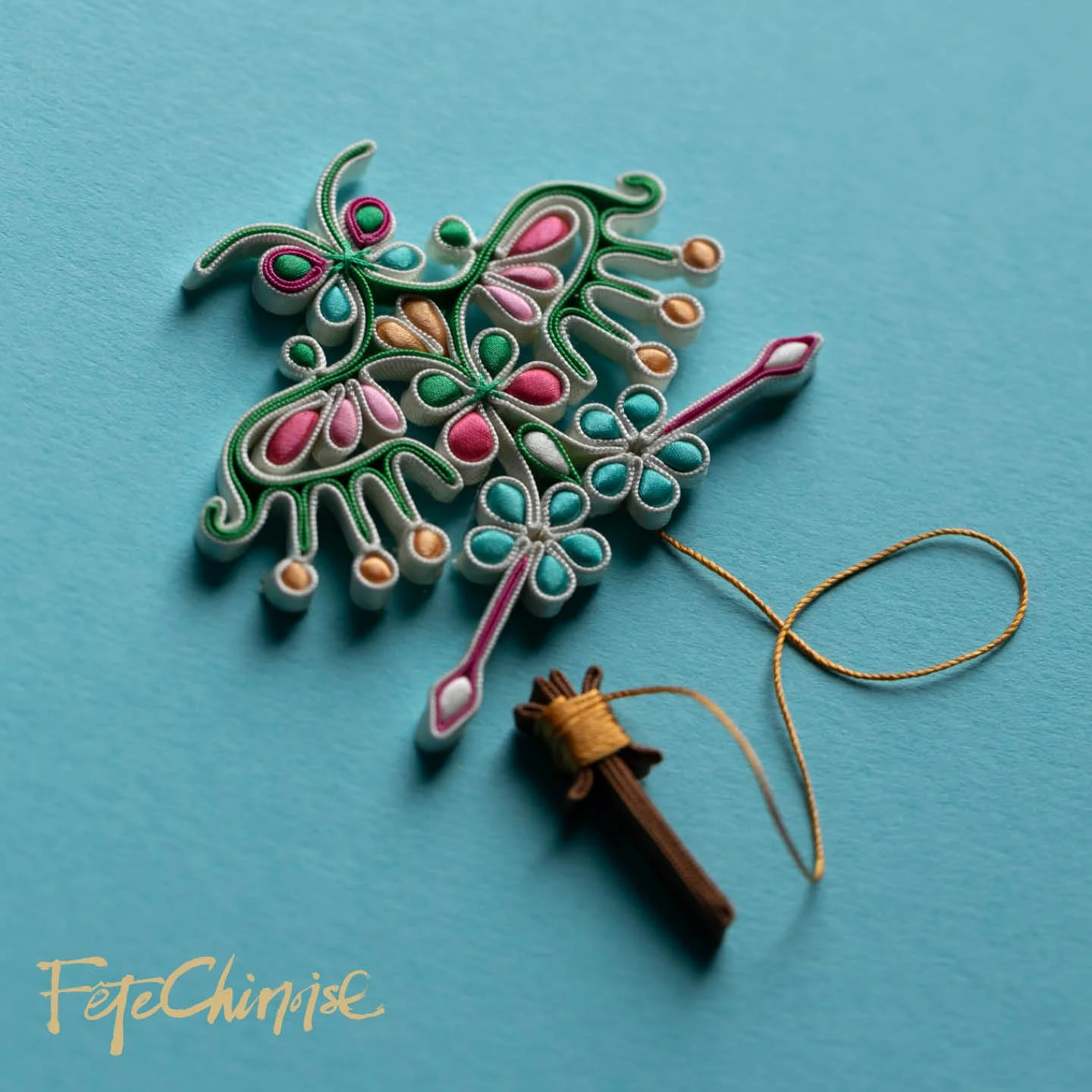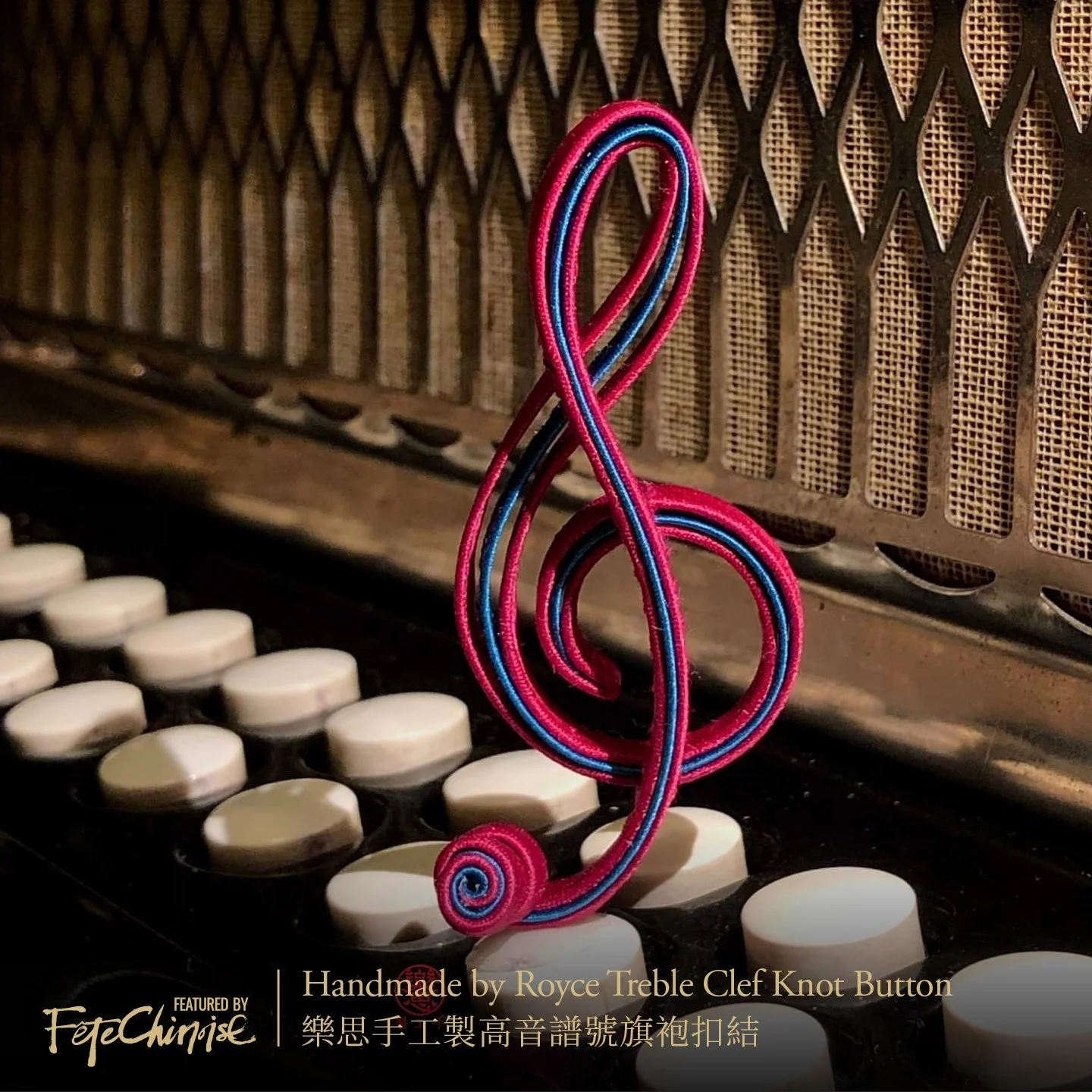An Enduring Elegance: Kwan Kwa Tradition 欣賞裙褂
Written by 撰文:Dr. Billy Tang Ka Jau 鄧家宙博士
Photography: Mike Chan
As featured in The Inaugural Art of Celebration Annual
A Sartorial Legacy Woven with History
For generations, the Cantonese people of Hong Kong have upheld a unique tradition – the wearing of the exquisite Kwan Kwa, a traditional bridal ensemble consisting of a jacket and long skirt, for weddings.
While not exclusive to the region, this elegant attire has been meticulously preserved and distinctly developed in Hong Kong, rendering it a cultural icon that embodies the city's rich heritage.
Tracing its roots back centuries, the Kwan Kwa is a harmonious fusion of a cross-collar jacket and a flowing long skirt. The intricate structure comprises the collar, front edge, top fly, sleeves, hem, and waistband or sash belt. The long skirts feature various designs, with pleats and the four-part skirt being particularly prevalent. Skilled embroidery artisans in Guangdong employ exquisite techniques to adorn these areas with auspicious patterns, imbuing the solid and dignified Kwan Kwa with brilliance and dynamism. Its origins can be traced back to the Ming Dynasty, when it first took shape as formal womenswear. Later, the Manchu people widely adopted and modified the jacket, with the horse jacket – designed for convenient horseback riding – becoming the most recognizable variant.
廣東華人有種獨特的傳統,遇上婚嫁普遍都堅持穿著裙褂,儘管裙褂不是香港獨有的禮服,卻因為歷史因素在這裡獲得保留及持續發展,使裙褂成為屬於香港的文化ICON。
裙褂,本稱褂裙,顧名思義是由上身對襟褂衣搭配長裙,早在明代已具初型。後來經滿州人廣泛吸納改成不同長度的褂衣,尤以便利騎馬的馬褂最為人熟悉。清初,朝廷將長衫馬褂定為官服,又規定漢人跟隨滿人衣著習慣,男裝長衫馬褂及女裝褂裙成為國民的基本衣著款式。乾隆時期,曾調派三百滿軍駐紮廣州,他們在省城狀元坊定居,日常僱請本地繡莊訂造官服及生活服,經過長期磨合,裁縫們逐漸掌握滿人衣著風格,又因應南方氣候等改良衣料及融和地道的盤金剌繡,發展成廣東褂裙。
During the early Qing Dynasty, the imperial court designated the long skirt and horse jacket as official attire, mandating the Han Chinese to embrace the sartorial customs of the Manchus. This decree laid the foundation for the basic clothing styles that would prevail among the populace at that time.
A Confluence of Cultures Shapes a Masterpiece
In the reign of Emperor Qianlong, three hundred Manchu soldiers were stationed in Guangzhou. As they settled in the provincial capital, they regularly commissioned local embroidery workshops to tailor their official and daily wear. Through this long-term collaboration, the tailors gradually mastered the Manchu dressing style, while also adapting the fabric to suit the southern climate and incorporating authentic gold and silver thread embroidery. This fusion of influences gave birth to the distinctive Guangdong-style Kwan Kwa.
The Kwan Kwa Enshrined in Law
With the establishment of the Republic of China, the regulations on clothing were enacted to enhance the appearance and dignity of citizens. Traditional male attire consisted of a blue cheongsam (long skirt) paired with a black jacket, while traditional female attire comprised a black jacket and a red skirt. These ensembles were designated as national formal wear, marking the first time in Chinese history that universal formal wear was established by law. Consequently, the Kwan Kwa became a popular fashion choice for women of that era.
褂衣的基本結構分為:褂領、褂柱、褂心、褂袖、褂腳及子孫帶等部分;至於長裙款式較多元,常見有百褶裙和四幅裙。廣東的繡藝師在這些位置以精湛技藝盤繡吉祥圖案,為穩重厚實的褂服注入璀璨和動感的元素。有別於一般刺繡,盤繡是將金銀線在布面盤出圖案,除起針和收針外,金銀線不會穿透布面,僅以絲線固定,如是者反覆以盤金、扣、疊、打籽、卜繡及疏圈等技法來完成構圖,成品稱為褂片。一套裙褂由最初三幅擴展到現今九幅褂片組成,再為客戶量身縫合成稱身的裙褂。
民國建立,為增進國民儀表體面而訂立《服制條例》,將傳統的男裝藍色長衫配黑褂及女裝黑褂紅裙列為國民禮服,是中國史上首次以法律方式確立的全民禮服。自此,褂裙成為當時女士的流行服飾,並按場合需求分為:日常起居穿著的生活褂,用色不拘,以清素色系為主,配少許繡花點綴,淡雅清新;繡花褂多為民間婦女穿著,在傳統規格上繡以花鳥圖案,用於婚嫁或其他重要場合;龍鳳褂多以金銀線盤繡圖案,寄意龍鳳呈情(情長),多為新娘所穿;壽褂則是滿六十歲的女性長輩的禮服,昔日也是預備百年後入殮的壽衣。
Depending on the occasion, the Kwan Kwa was divided into different types: the daily wear life jacket, featuring plain colours with minimal embroidered decorations, exuding an elegant and fresh style; the embroidered Kwan Kwa, mostly worn by women for weddings or other important occasions, adorned with traditional floral and bird patterns; the dragon and phoenix Kwan Kwa, embroidered with gold and silver threads, symbolizing a harmonious and lasting relationship, and often donned by brides; and the longevity Kwan Kwa, also called the birthday Kwan Kwa, the formal attire for elderly women once they reached the age of 60, which in the past was sometimes prepared to be used as a shroud.
Hong Kong: A Sanctuary for Kwan Kwa Artistry
As early as the 1920s, high-end embroidery shops specializing in crafting exquisite jackets and skirts for the affluent residents of the Mid-Levels lined the streets of Wellington Street and Lyndhurst Terrace in Central, Hong Kong. After the establishment of the People's Republic of China, the wearing of traditional garments such as cheongsam, horse jackets, and Kwan Kwa was deemed a symbol of feudal culture and prohibited. Consequently, the embroidery workshops and artisans engaged in Kwan Kwa embroidery in Guangzhou relocated to Hong Kong, leaving only the residents of Hong Kong and Macau to uphold the tradition of wearing Kwan Kwa.
Modernity and Tradition Entwined
In response to the changing economy and urban lifestyle after the war, Hong Kong's embroidery shops adapted their garments and business models. In addition to custom-made and ready-to-wear Kwan Kwa, they introduced rental services, allowing customers to pay a deposit and rental fee for a decent Kwan Kwa attire. Designs were also updated to cater to modern fashion preferences, with the traditional black jacket replaced by a festive red hue, and the loose-fitting raglan sleeves modified to resemble suit sleeves, creating a more form-fitting silhouette that accentuated the female figure.
早在一九二零年代,中環威靈頓街、擺花街已是高檔繡莊林立的地帶,專為居住於半山的紳商訂造華麗的褂裙服裝。新中國成立,當時視長衫馬褂、褂裙及旗袍是封建文化的標誌而禁止穿著,原在廣州從事褂裙剌繡的繡莊及繡藝師也遷到香港開業,全國之內就僅餘港澳兩地市民保持穿褂的習慣。
香港繡莊鑒於戰後經濟力及城市人生活模式也改良褂服及經營模式,在原有訂褂賣褂外增設租褂服務,客戶只需交付按金及租金就能租用體面的褂服;款式方面,考慮到現代人衣著審美的改變,將黑色褂衣改為紅色增添喜慶感,又將傳統寬身的連肩袖改為西裝膊款,使褂服更為貼伏,更能呈現女士的體態線條。材料方面廣泛吸收製衣業的技術和原料,引用圖紙繪畫圖樣便利大量生產,同時以塑膠珠片、玻璃石等衣飾配件繡製圖案,大幅降低製褂的成本,創製出具地道特色的香港裙褂,既為客戶提供更多的選擇,也擴大繡莊的生意額,變相延續了裙褂文化。
The industry also incorporated techniques and materials from the garment industry, utilizing pattern templates for mass production and incorporating plastic beads, glass stones, and other accessories to embroider patterns, significantly reducing production costs. This led to the creation of the Hong Kong-style Kwan Kwa, with its distinctive characteristics such as closer-fitting silhouettes, incorporation of modern materials like plastic beads and glass stones, and fusion of traditional embroidery with contemporary design elements, providing customers with more choices and expanding the business of embroidery shops, thereby indirectly preserving the Kwan Kwa culture.
Sustaining Embroidery Skills
While embroidery shops serve as the foundation for preserving Kwan Kwa embroidery craftsmanship, their business experiences fluctuations as the demand for Kwan Kwa becomes more specialized.
During auspicious “double spring leap year” cycles in the Chinese lunar calendar, when weddings are considered more prevalent and fortunate, embroidery shops experience a surge in demand for Kwan Kwa ensembles. Conversely, business tends to be quieter during so-called “blind years,” which are believed to be inauspicious for weddings based on traditional Chinese beliefs and astrology. Additionally, the first half of the year, with its Lunar New Year, Qingming Festival, and Ghost Festival celebrations, as well as the onset of warmer temperatures, sees fewer weddings taking place, resulting in a low season for embroidery shops. It is not until August to mid-December, in the lunar calendar, that business enters its peak wedding season.
無可否認,繡莊是承傳裙褂繡藝的基地,隨着裙褂用途趨於單一化,繡莊業務亦有淡旺季週期。凡農曆「雙春兼閏月」的年份,傳統上大利嫁娶,較多人結婚,自然帶動繡莊生意。而「盲年」的生意則較淡靜;至於每年上半年因過年、清明、盂蘭等節俗及天氣炎熱,較少人選擇結婚,也是淡季,要到農曆八月至十二月中生意才進入旺季。除了銷售裙褂外,製造廟宇的神功用品也是繡莊的重要業務,其生意額更佔全額半數以上,也是另一個展現高超繡藝的項目。
隨時代改變,繡莊運作也有變更。早期的繡莊只接受訂製,需僱請多名繡藝師傅駐店,香港增設租褂業務後,以裙褂成品供應市場,店面只留用一位繡藝師,改而增聘店務員專責招待及銷售工作。現今,具規模的繡莊會聘請設計師協助開發新褂款。至於港九各區的小型繡莊屬小本經營,在租褂服務外兼賣家品雜貨,幫補生意。
Besides selling Kwan Kwa, embroidery shops also engage in the production of ceremonial items for temples, which comprises more than half of their total revenue and serves as another platform to showcase their superb embroidery skills.
With the changing times, the operations of embroidery shops have also evolved. While they initially accepted only custom orders and required multiple embroidery artisans on-site, the introduction of rental services in Hong Kong led to the supply of ready-to-wear Kwan Kwa to the market.
Larger embroidery shops now hire designers to assist in developing new designs, while small-scale shops in different districts of Hong Kong operate on a smaller scale, selling miscellaneous household goods in addition to providing Kwan Kwa rental services to supplement their business.
作為傳統手藝行業,從業者需長期在眼力與精神高度集中的狀態進行繡製工作,已令人卻步。加上香港高速城市化及高學歷的氛圍,繡莊正面對生意額緊張和青黃不接的問題。有見及此,近年也注入新元素,除改良裙褂的設計剪裁,也採用水晶等材料,更有將卡通人物圖案融入褂款內,這類新潮褂甚受年青一代的歡迎;亦有將傳統盤繡手藝延伸至其他的生活用品,擴大公眾的接觸面和使用率。
近年,因裙褂技藝列入香港非物質文化遺產代表作名錄,透過公眾講座、手藝工作坊和展覽會加強推廣,提升大眾欣賞裙褂文化的能力。期望更多人認識裙褂、喜歡裙褂,甚至一同傳承手藝,延續香港裙褂文化。
As a traditional craft industry, the practice of Kwan Kwa embroidery demands intense concentration and visual acuity, which can be daunting. Moreover, with Hong Kong's rapid urbanization and highly educated atmosphere, embroidery shops face challenges in terms of revenue and a lack of successors. In response, new elements have been introduced in recent years, such as incorporating crystals and integrating cartoon characters into the designs, appealing to the younger generation. Traditional embroidery techniques have also been extended to other daily life products, expanding public exposure and usage.
Preserving a Cultural Treasure
In recent years, Kwan Kwa embroidery has been officially included in the Representative List of the Intangible Cultural Heritage of Hong Kong, recognizing its cultural significance. Concerted efforts have been made to promote appreciation of Kwan Kwa culture through initiatives like public lectures, hands-on craft workshops, and exhibitions showcasing this exquisite artform.
The aim is to increase awareness, especially among younger generations, and encourage the transmission of Kwan Kwa embroidery skills and traditions. By safeguarding this integral piece of Hong Kong's heritage, the hope is that the Kwan Kwa's radiant legacy will endure for generations to come.


























In Chinese culinary tradition, the Longevity Peach Bun (or Shoutao), holds a special place. Often found at birthday banquets for the elderly, this delightful treat is more than just a delicious dessert—it is a symbol of health, prosperity, and a long life. With its unique appearance and cultural significance, the symbolic bun continues to be a staple at celebrations as traditions are passed down generations of families in Asia and in diasporas around the world.